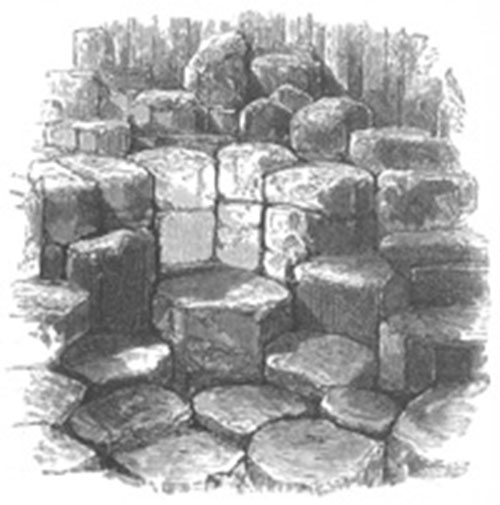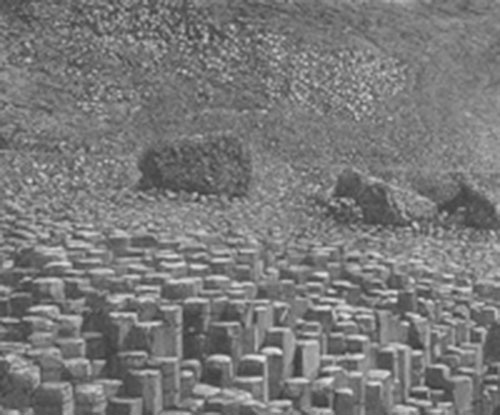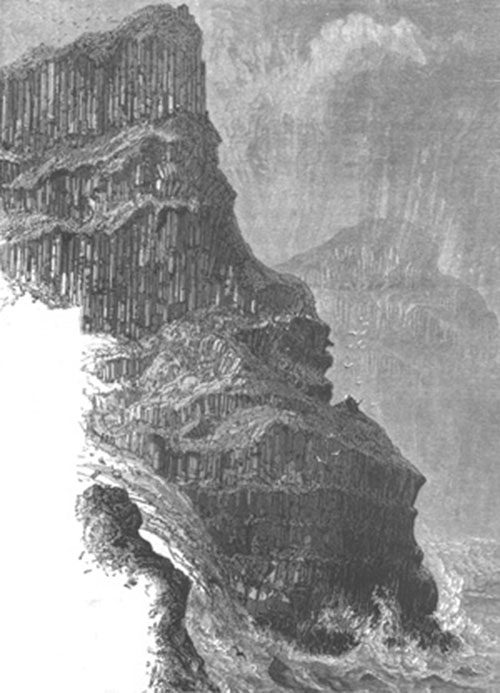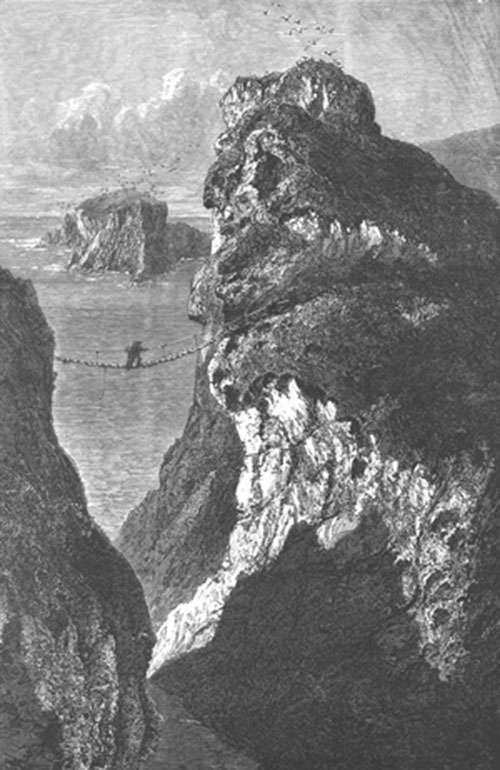The Giant's Causeway - Irish Pictures (1888)
From Irish Pictures Drawn with Pen and Pencil(1888) by Richard Lovett
Chapter X: The Giant's Causeway and the Mourne Mountains … continued
« Previous Page | Start of Chapter | Book Contents | Next Page »
The Causeway, like Killarney, suffers from a plague of guides. Escape from them is well-nigh impossible. The best thing is to take one from the hotel, and keep rigidly to the arrangement by which his services are included in the bill. It is a great misfortune that the visitor should not be able to roam at will about this magnificent piece of coast scenery. There are few places better fitted to arouse wonder at the marvellous works of God in Nature; there are few spots even along the grand west coast that contain so much to delight the eye and the mind. But the horde of guides, and the constant expectation that the next turn of the path will bring you either to a beggar, or a seller of spring water, or to a vendor of the minerals of the neighbourhood, goes far to banish all the higher enjoyments of the place.
The first view of the Causeway is not unfrequently such a contrast to what imagination has pictured, that there is disappointment and a temptation to run to extremes in denouncing previous descriptions. But as the true nature of the coast is comprehended, as the beautiful forms of the pillars are appreciated, and as one after another the many geological marvels of the region are noted, these feelings disappear. In their place comes a truer realisation of the grandeur of the scene. 'Along the north coast,' writes Professor Hull, 'the scenery is often bold and striking; sometimes, as in the neighbourhood of the Giant's Causeway, the cliffs rise from the sea in a series of terraces of dark columnar basalt, with vertical walls, and separated from each other by bands of reddish bole, or volcanic ash. These great beds or terraces represent successive lava flows, and they differ from one another not only in thickness but in the size and arrangement of the columns. At other times, as at Fair Head, directly opposite the Mull of Kintyre, huge columns of basalt descend from the top of the cliff in one or two sheer vertical sweeps for several hundred feet, while at the base of the cliff the shore is strewn with broken columns of trap heaped up in wild confusion: a Titanic breakwater which the waves of the sea have reared up against their own advance.'[1]
The best way to get a good general idea of the beauty and boldness of the coast about the Causeway is to take a boat and row westwards to Porthcoon and to Dunkerry Caves. The boat can easily enter both in fine weather, the only time when the row is practicable. Porthcoon is 350 feet long and 45 high, and exhibits fine colouring, owing to the presence in the rocks of peroxide of iron. Dunkerry is much larger, being 600 feet long and 96 feet high. To those who like this class of natural phenomena the trip may be recommended; others may be apt to feel that there is in the caves hardly enough to compensate for the boat trip, the damp atmosphere, the rather strong sea-weedy odours, and the persistent way in which the boatmen try to sell you boxes of geological specimens, which are utterly unreliable, and probably have been carried to the Causeway with an eye to large profits.
On leaving the caves, the boat turns eastwards and runs along the splendid coast for either a short or a long trip, as the traveller decides. Those who enjoy being on the water should extend the trip as far as Benmore or Fair Head. The usual excursion is much shorter. Running past the Causeway proper all the bays and headlands as far as Pleaskin are seen, and then the boat returns and lands the passengers upon the Causeway. This consists of an enormous number—about 40,000—of basaltic columns, only a few feet above the level of the sea, jutting out from the cliffs of the same formation, rising two or three hundred feet immediately behind them. They gradually sink beneath the waves, forming a most magnificent natural pier. How far beneath the waves they extend is not known. But as the same formation exists at Staffa, it is commonly supposed that they extend across to the Scotch coast. The Celtic imagination has settled that the Causeway was the work of the giant Fin McCoul, whose Scotch rival boasted of his ability to thrash him, but objected to getting wet in crossing over to do so. Whereupon Fin magnanimously built the Causeway and defeated his rival. In later days, on the disappearance of the giants, the Causeway sank beneath the waves.
A perverse ingenuity is shown here in twisting every group of pillars into some connection with the giant. Just as at Killarney one is pestered with the O'Donoghue's honeycomb and book and pulpit, &c, so is it here ad nauseam. The giant's loom, and gateway, and organ, &c. &c, are indicated by the loquacious guide, who generally accompanies his absurd information with the query as to whether his victim has ever seen anything so fine before in his life. If the proprietors of the Causeway Hotel could provide a few intelligent men, able to point out the geological marvels of the district with some approach to accuracy, they would confer a boon upon travellers. Large numbers who visit the Causeway despise the nonsense that is talked at present; but for want of knowing exactly what to see, they fail altogether to appreciate the unique claims which the Causeway has upon our wonder and admiration.
It ought, in fairness to the guides, to be mentioned that when upon the Causeway itself they do enable the visitor who displays any interest in the subject to appreciate the wonderful regularity of formation of the pillars, and the beautiful way in which they are grouped. The ladies' chair, the fan, the honeycomb, &c, are their fanciful names for what are very striking arrangements of the pillars. The guides also assert that there is only one triangular pillar, three with nine sides, comparatively few with four and eight sides, the overwhelming majority having either five, six, or seven sides.
The clusters known as the Giant's Loom and Gateway stand at the eastern cliff end of the Causeway, and are beautiful specimens of the formation. A splendid cluster on the face of the cliff is called the Giant's Organ. In one part, instead of the vertical, a horizontal formation can be clearly seen, the ends of the pillars being at right angles to the cliff. But fully as wonderful as the Causeway, and much more impressive, are the mighty masses of the Amphitheatre, a superb semicircular cliff, in which the pillars occur in stages; the Chimneys, a cluster of pillars standing on the apex of a bold headland; and the grand cliff, nearly 400 feet high, named Pleaskin Head. All along these cliffs the pillar clusters and masses of richly-coloured rocks, seen under a bright sky, and washed by a sunlit sea, constitute a gallery of the most delightful and exhilarating natural pictures.
But we must push on, and follow the road along the Coast to Larne. Just as in Norway, travellers, wishing to see the Romsdal to perfection should approach it through the quieter scenery of the Gudbrandsdal, so the Causeway should be approached rather than left by this route. It is true that Fair Head is grander far than anything the Causeway can show, but that is really a part of the same piece of coast. The road passes many points of interest which can only be inspected by the leisurely wayfarer. Dunseverick Castle, and Carrick a Rede, the island which can only be reached by the perilous swinging bridge, are within easy reach of the Causeway. For Fair Head Ballycastle is the starting-point, a little town where good accommodation is to be had. It is also a good point from which to reach Rathlin Island, another of those coast trips which depend so entirely upon the weather. The island possesses very fine cliffs, and only one harbour, which is unavailable during westerly winds, the commonest along this coast. Columba, here as in so many other places, is said to have founded a church; and Robert Bruce not only found a safe refuge on the island, but is also said to have derived his encouragement from the famous persevering spider while concealed in the castle still known by his name.
NOTES
[1] Physical Geography of Ireland, pp, 61, 62.
« Previous Page | Start of Chapter | Book Contents | Next Page »




